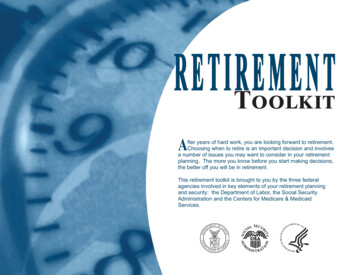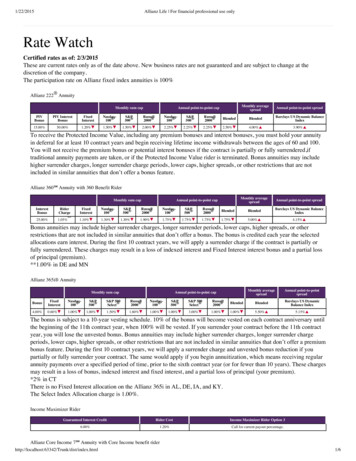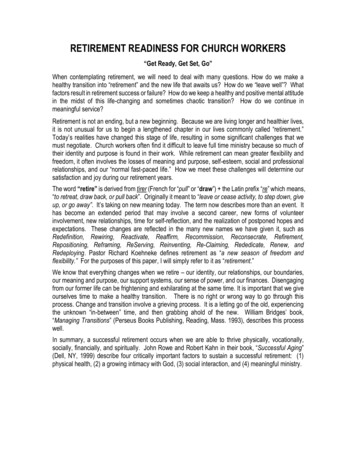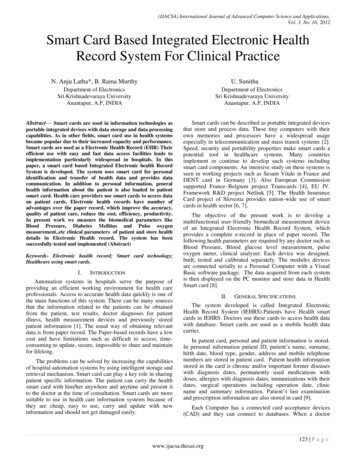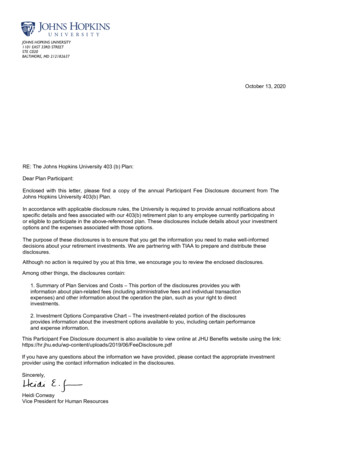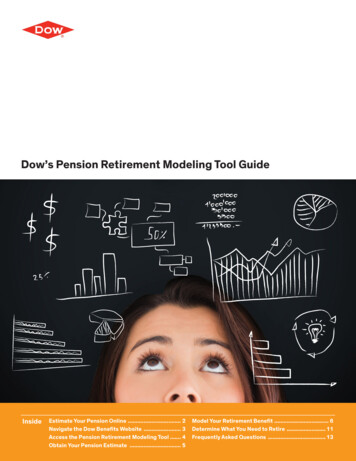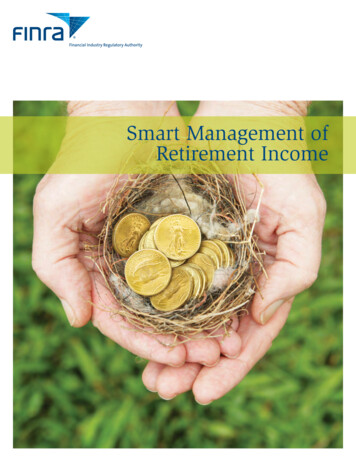
Transcription
Smart Management ofRetirement Income
Table of ContentsIntroduction1Getting Ready for RetirementLiving Expenses in RetirementRetirement TimetableWorking with Investment Professionals2223Sources of Retirement IncomeSocial SecurityDefined Benefit PlansDefined Contribution PlansHome EquityReverse Mortgages445678Selecting Payout MethodsPension Payout OptionsDefined Contribution Payout Options9911Managing Investment PortfoliosReassessing RiskAsset AllocationIncome InvestmentsGrowth InvestmentsIncome from Selling Your InvestmentsMaking Your Principal LastSelling Your InvestmentsFees & Expenses131314141515151616Taxation of Retirement IncomeTaxation of Social Security BenefitsTaxes on Tax-Deferred and Pension IncomeTaxable AccountsPlanning for Gifts and BequestsKeeping Up with Tax Changes171717181919Working in RetirementSocial Security and Limits on Earned IncomeImpact on Pensions and Other Retirement PlansJobs and Required Minimum Distributions20202121Long-Term PlanningChoosing Pension and Insurance BeneficiariesChoosing IRA BeneficiariesPower of AttorneyLiving Wills2222232424Health Care CostsHealth InsuranceLong-Term Care Insurance252525
Smart Management of Retirement Income1IntroductionWhen you retire, you have more control over your time, and finally have enough leisure to do what youwant. While taking control of your time may not require a lot of advance planning, taking control of yourretirement finances does. You need income you can count on, year in and year out for a very long time.This brochure offers you tips on the subjects listed below to help you manage your retirement income.Getting Ready for RetirementWhether your retirement is fast approaching or years away, there are actions you can take now tomaximize retirement when the time comes. It’s never too early or too late to start.Sources of Retirement IncomeManaging retirement income starts with knowing what your sources of income will be—Social Securityan employer-sponsored retirement savings account—and the rules that govern each income source.Selecting Payout MethodsWhen you retire, you begin to take income from your defined benefit pension or defined contributionplan. You may also take income from a Social Security account. You should learn about the payoutoptions from each source and what each means for your personal situation.Managing Investment PortfoliosRetirement income management is all about making sure your retirement savings provide enoughincome for your needs, and that you don’t outlive your assets. This starts with setting up and managinga portfolio that’s right for you.Taxation of Retirement IncomeWhen you retire, you leave behind many things—the daily grind, commuting, maybe your old home—but one thing you keep is a tax bill. In fact, income taxes can be your single largest expense in retirement.Working in RetirementYou’re retired, but you may want to go back to work. You should, however, understand exactly howworking after retirement might affect your Social Security, pension benefits, and other retirement income.Long-Term PlanningOnce retired, you may have questions about the future — particularly about how your spouse and familywill cope financially if you become disabled or die and what will happen to the assets in your estate afteryour death. These valid concerns underscore the importance of solid long-term planning.Health Care CostsYour plans for the future shouldn’t just be about what happens to your property or financial affairs.The longer you live in retirement, the greater the likelihood that you will need to use health insuranceor arrange for long-term care. TOC
Smart Management of Retirement Income2Getting Ready for RetirementBefore you retire, you’ll need to consider these questions:00What sources of income are you confident you’ll receive?00How much income will these sources provide each year?00How and when will the income be paid?00How will you coordinate payments from different sources to create a steady streamof income so there’s money for as long as you need it?In most cases, the longer you work and the higher your salary, the more retirement income you cananticipate. If your employer offers a traditional pension, the pension income you receive will depend on theyears of service, your salary and the age when you stop working. On the other hand, tax-deferred retirementplans—including employer-sponsored retirement plans such as 401(k)s, 403(b)s, individual retirementaccounts (IRAs) and annuities—provide income based on the amounts you put in them, the investmentchoices you made and the way those investments performed.Living Expenses in RetirementManaging retirement income successfully starts with making sure your expectations for retirement arerealistic. This requires that you have a clear picture of how much you’ll spend both on the everyday costsof living and on any special activities you’re planning.Many retirement experts estimate you’ll need between 70 and 85 percent of your pre-retirement income tomaintain your standard of living after you stop working. But that formula might be too simple, and possiblytoo low, to account for what you’ll actually spend. You’ll need more if you have expensive hobbies or plan totravel extensively. You may also need more if you’re in poor health and have substantial medical expenses.Start by tracking what you actually spend now.Remember that many costs will go up over time—likely candidates include healthcare, food, property taxesand travel. Costs that could go down include your mortgage, commuting (including the need for a secondcar), clothing and financial expenditures for your children and your parents.Retirement TimetableWherever you are on the retirement timetable, it’s important to keep some critical ages in mind:55:You can retire early. If you retire, quit or are fired from your job beginning in the year you turn 55,you might be able to withdraw from tax-deferred savings plans without owing a 10 percent taxpenalty, as long as you qualify for one of the exceptions spelled out in the federal tax code. You mayalso be eligible for pension benefits from some employer plans if you have enough years of service.Smart Tip: Create an Emergency FundYou can’t predict what might happen to your finances, but you can prepare by creating an investmentor savings account equal to three to six months of living expenses, earmarked for emergencies.You probably will want to keep this rainy-day money in accounts that protect their value, such assavings or money market accounts, or U.S. Treasury bills. TOC
Smart Management of Retirement Income359½: You can generally withdraw money from your personal tax-deferred savings plans (IRAs, annuities)and from your employer-sponsored savings plans if you’ve retired from the job without owing a10 percent tax penalty.60:You can receive Social Security benefits if you are a widow or widower.62:You may be eligible for full pension benefits from your employer, depending on the plan. You canbegin to receive reduced Social Security benefits if you choose. Your Social Security benefits willincrease, however, with every year you wait to collect them.65:You can receive full pension benefits from most employers, as well as full Social Security benefits ifyou were born in 1937 or earlier. If you are a widow or widower, you can receive full Social Securitybenefits if you were born before January 2, 1940. If you were born later than 1937, when you reachwhat’s called full retirement age and are eligible for full benefits depends on the year of yourbirth. For those born between 1938 and 1942, it’s during the year after you turn 65. For those bornbetween 1943 and 1954, it’s 66. For those born between 1955 and 1960, it increases annually from66 and 2 months to 67. If you were born in 1961 or later, your full retirement age is 67. At 65, younormally also qualify for Medicare benefits.70:You should begin to collect your Social Security benefits if you haven’t already, because your benefithas reached its maximum.70½: You must begin withdrawals from your traditional IRAs, but not from Roth IRAs. You must alsobegin withdrawals from employee-sponsored retirement plans, such as a 401(k), unless you’restill working.Working with Investment ProfessionalsMany people who are approaching retirement or have recently retired turn to a professional to seek helpplanning for that event and managing their income. If you’re looking for that kind of help, you may needto shop around to find someone you like and trust. For information on different types of investmentprofessionals and how to select them, read FINRA’s Selecting an Investment Professional. Always useFINRA BrokerCheck to learn about the licensing and background of the individuals you’re considering.And if an investment professional says he or she has special credentials or designations, be sure to useFINRA’s Understanding Professional Designations tool to see whether the issuing organization requirescontinuing education, takes complaints or has a way for you to confirm who holds the credential.!Caution: Look Before You Leave!While early retirement is an alluring prospect, be advised that some early retirement strategies arein fact schemes designed to take your money. FINRA is aware of instances in which employees whohad built up sizeable retirement savings have been misled—and financially harmed—by flawed, evenfraudulent, early-retirement investment schemes. For more information about how to protect yourself,read the Investor Alert, Look Before You Leave: Don’t Be Misled By Early Retirement Investment PitchesThat Promise Too Much.Smart Tip: Allow Three-Months Lag Time When Appling for Social SecurityThe Social Security Administration (SSA) recommends applying for retirement benefits three monthsbefore you want your benefits to begin. You can get an estimate of your future benefits at any time.For more information, see the SSA’s Web page How should I prepare for retirement? TOC
Smart Management of Retirement Income4Sources of Retirement IncomeSocial SecurityFor many, Social Security will be a vital—and significant—source of retirement income. Unlike most sourcesof retirement income, Social Security benefits are adjusted periodically for inflation through automatic costof-living adjustments, or COLAs.Perhaps the biggest decision you’ll make about Social Security is when to apply for your benefits. You cantake reduced benefits at 62, wait until you’re eligible to receive your full benefits—which will depend onthe year in which you were born—or postpone your first payment to qualify for a larger amount.The SSA offers many tools and resources to help you understand your Social Security benefits and how bestto plan for the day when you will tap those benefits to help fund your retirement. Here are a few to explore:Find Your Full Retirement AgeWhen to Start Receiving Retirement BenefitsSocial Security Retirement PlannerLife Expectancy CalculatorSocial Security ChecklistWhen you apply for benefits, you’ll be asked to provide a number of documents. You must submit originalsor copies certified by the issuing office, as the SSA does not accept photocopies. If you know what thosedocuments are before you’re ready to apply, you’ll have a head start on getting them together.Here’s a checklist of some documents you may need when you sign up for Social Security: Your Social Security card (or a record of your number)Your birth certificateProof of U.S. citizenship or lawful immigration status if you were not born in the U.S.Your spouse’s birth certificate and Social Security number if he or she is applying for benefitsbased on your earnings Marriage certificate (if applying for spousal benefits) Your military discharge papers if you had military service Your most recent W-2 form, or, if you’re self-employed, your tax returnDrawing Social Security IncomeIf you and your spouse are both eligible for Social Security benefits based on your work histories, you’ll facea key choice. You must decide together whether to draw on your individual accounts or have one of youdraw what are called spousal benefits.If you and your spouse earned approximately equal amounts over your working lives, drawing on yourindividual accounts will provide the greatest benefits. But if one of you earned substantially more than theother, you’ll want to compare your alternatives. If you are eligible for both your own retirement benefitand for benefits as a spouse, SSA will always pay you benefits based on your record first. If your benefit asa spouse is higher than your retirement benefit, you will receive a combination of benefits equaling thehigher spouse’s benefits.If you have a minor child, you may be eligible for additional Social Security benefits. TOC
Smart Management of Retirement Income5Defined Benefit PlansIf you have a defined benefit pension, you should know before you retire about how much pension incomeyou’ll receive. This income is typically based on how long you worked at your company, what you earnedand your age when you stopped working. But either way, as you approach retirement, you should checkwith your employer’s human resources office on a number of pension eligibility questions. And after youretire, the office should still be a valuable resource.Start with the most important thing: verify that you are fully vested—that is, eligible to collect a fullpension. Many private company employees become vested after five years of service, or gradually betweenyears three and seven.You should also ask your employer what happens to your pension plan benefits if you retire sooner than65 or work past that age. Some companies might decrease the amount of pension you would otherwisereceive if you stop working earlier or later than 65.If you’re married and are part of a defined benefit plan, your employer is legally bound to pay some of yourpension amount to your surviving spouse when you die. The amount may be set at 50 percent, but you maybe able to increase it. If you don’t want your spouse to get any of your pension, your spouse must sign awritten consent waiving rights to this income.Pensions can be a major attraction to people working in the public sector and armed services. Governmentpensions and military retired pay tend to differ from corporate pensions in several ways:00Government employees may be required to contribute a percentage of their after-tax earnings totheir pensions.00Government employees and military service members may be able to receive their pensions aftera set time—such as 20 or 30 years—no matter how old they are or how close they are to the moretraditional retirement age of 65.00Government pensions and military retired pay tend to be adjusted automatically for inflation usinga cost of living index adjustment, or COLA.Pension Plan ProblemsA good place to start with general questions and problems related to your pension is the Department ofLabor’s Employee Benefits Security Administration (EBSA), which regulates retirement plans. You maycontact EBSA toll-free: 866-444-EBSA (3272).A pension plan is occasionally terminated if a company is bought, goes out of business or decides tofreeze or change its employee benefits structure. If that happens, you will be notified in writing at least60 days before the plan ends. Sometimes you’ll also see a notice of a plan termination in local and nationalnewspapers. You should later get a separate letter explaining what benefits, if any, you will receive.Many company pensions are insured by the Pension Benefit Guaranty Corporation (PBGC). This federally runorganization was set up to protect defined benefit pensions—including those that end because an employerterminates a plan. The benefits the PBGC pays when it takes over a pension plan are capped. In that case,highly paid individuals may lose part of their anticipated benefits. Also, if you lose track of your pension oryour employer mismanages your plan, you can ask for help from the PBGC.Smart Tip: Unclaimed Pension?You can search for a pension you think you might have a right to on the PBGC’s website.All you need is your name and the name of your former employer. TOC
Smart Management of Retirement Income6Defined Contribution PlansIf you have a defined contribution plan, your employer may put money into the plan, allow you to contributeor sometimes contribute if you do. But, unlike a defined benefit pension, your employer doesn’t make anypromises about the income you’ll receive when you stop working. Instead, that amount depends on howmuch money was invested, where it was invested and how long you’ve been in the plan.Employer-sponsored retirement plans—such as 401(k)s, 403(b)s and 457s—are the best-known definedcontribution plans. Other plans that generally cater to small businesses are SIMPLE IRAs and SIMPLE 401(k)sand Simplified Employee Pension (SEP) IRAs. These plans allow you to defer part of your current income intoa retirement plan. In most cases, you also decide how your money is invested by choosing among optionsoffered through the plan.Defined contribution plans differ from defined benefit plans. For one thing, most defined contributionplans offer quicker, or even instant, vesting rights on any contributions your employer has made—andyou are always automatically 100 percent vested in your own contributions and any earnings on thosecontributions.One other very important feature of defined contribution plans is that when you switch jobs, you canusually move or roll over your accumulated assets to your new employer’s plan or to an IRA. This way,you’re starting with a balance to build on when you start a new job. If you can’t move it, you can oftenleave your account with your former employer so it keeps growing until you retire.!Don’t Squander Your “Rollover Moment”Too many older Americans spend an entire life accumulating retirement savings, only to makechoices that harm their financial situation after they retire. When deciding whether to staywhere you are, roll over to an IRA, or move to a new employer’s plan (if you chose to work in“retirement”), these tips can help you avoid mistakes that can torpedo your retirement savings:00Take time to comparison shop. In most cases, you do not need to make a snap decisionwith respect to your current employer’s retirement savings plan.00Compare fees and investment choices. Fees in particular are a key consideration. Smalldifferences in cost can translate into big differences in the overall performance of yourinvestments. The Department of Labor’s A Look at 401(k) Fees provides answers to manycommon questions about fees and expenses. If you are considering an IRA, ask your brokerhow much it will cost to open the account and what ongoing costs are associated withyour potential investments.00Be wary of rollover sales pitches that make broad claims that brokerage accounts orIRAs are “free” or have “no fee.” Certain types of fees might not be charged, but othersmight—such as fees for opening, maintaining or closing accounts or costs associated withparticular investment products. For more information, read the Investor Alert.00Use diversification and other strategies to manage risk. It was important to do so whenyou were saving for retirement (most 401(k)s offer mutual funds that offer “instant”diversification and help manage risk). It is equally important in retirement.00Ask and check to be sure that both your investment professional and investments areregistered.00Make sure that some of your investments are liquid, meaning you are able to sell themquickly if you need to do so.00Consider engaging an independent financial professional to review your rollover andother financial decisions at retirement. TOC
Smart Management of Retirement Income7Too Much Stock in Your CompanyIf you have an opportunity to accumulate retirement assets through the purchase of company stock, youdon’t want to overdo it. See FINRA’s Investor Alert, Putting Too Much Stock in Your Company—A 401(k)Problem.A Defined Contribution ChecklistWhen you’re within a few months of retirement, it’s a smart idea to review what’s happening with your401(k), 403(b) or other employer-sponsored savings plan. Here are some of the questions you’ll want toask yourself or the people in your employer’s human resources department: What are my payout options?Will I be able to change my mind once I have made a decision?Could I postpone taking income from the account for a few years or until I turn 70½?Will I be able to change my allocation once I retire?For more information about 401(k) investing, see FINRA’s Smart 401(k) Investing.Home EquityYour home is also a potential source of retirement income. If you own your residence outright, or have builtup significant home equity, two of the most common ways to use your home to provide retirement incomeare to sell it or obtain a reverse mortgage.If you decide to sell your home, the objective is to use some portion of the proceeds of the sale to fundyour retirement. This assumes of course that the value of your house has gone up since you bought it.The Taxpayer Relief Act of 1997 allows you to sell your home and receive tax-free gains of up to 250,000if you are single and 500,000 if you are married.Since you need to live somewhere, an important decision will be whether to use the proceeds of the sale todownsize and purchase a less expensive home, or rent. If you decide to downsize and buy a less expensivehome, you will need to consider one of two options, purchasing another home outright or obtaining amortgage on the new home. The first option carries peace of mind (your house is paid for) but it will tieup more of your money, leaving less to generate income.On the other hand, taking out a new mortgage means you must cover the cost of the mortgage monthin and month out. If you go this route, it will be extremely important to manage your money to ensureit generates enough income to pay your mortgage.!Caution: Using Home Equity Loans to Invest is RiskyUsing a home equity loan to engage in speculative investing as a means to both cover the loanpayment and generate additional income is extremely risky. This may result in the loss of your homeif your investments go sour and you cannot repay your home equity loan. FINRA warns against thiscourse of action in our Investor Alert, Betting the Ranch—Risking Your Home to Buy Securities. TOC
Smart Management of Retirement Income8Reverse MortgagesIf you’re at least 62 and live on a fixed income, you might also get retirement income from a reversemortgage. Officially called home equity conversion mortgages, they allow you to convert your homeequity to a loan. You can take the proceeds as a lump sum, a series of regular payments or a line of credit.An appealing feature of a reverse mortgage is that no income tax is due on the money you receive, becauseit’s a loan, not income.But reverse mortgages are tricky—and definitely not for everyone. That’s because once you take a reversemortgage, your debt to your reverse mortgage lender grows with each payment you receive. That debt mustbe repaid when you die or move out of the home, usually by selling the property. The total amount that’sowed can’t be more than the value of the property, but it can equal the sale price. Plus, reverse mortgagescome with closing costs, just like a regular mortgage—and these closing fees can be thousands of dollars.The amount of income a reverse mortgage provides depends on your age, how much equity you have inyour home and the interest rate the lender is charging. Some reverse mortgages are insured, which addseven more to the cost of borrowing but guarantees you’ll receive your payments no matter what. Also,some reverse mortgages let you lock in your interest rate prior to closing just like with a regular mortgage,so you’ll have a better idea of how much you can actually borrow beforehand.THE SCORECARD FOR REVERSE MORTGAGESPROS:CONS:Ready source of cashLoan must be repaidNo income taxes on payments because it’s a loan,not incomeAmount available to borrow may be smallNo capital gains taxes, though loan amount isbased on the current value of your propertyPossibility of paying high interest rates andclosing costsNo reduction of Social Security paymentsReduced estate to leave to your heirsTo help sort out the pros and cons of reverse mortgage in more detail, AARP provides an online seminarcalled Homemade Money: A Consumer’s Guide to Reverse Mortgages. For more information, you can checkout what the Federal Trade Commission says about reverse mortgages. The U.S. Department of Housingand Urban Development (HUD) also has a page on reverse mortgages for seniors.Smart Tip: Make Sure the Survivor Can Stay in the HouseBoth you and your spouse should be included in a reverse mortgage to ensure that, after one passesaway, the survivor can stay in the house. TOC
Smart Management of Retirement Income9Selecting Payout MethodsOne big change that retirement brings is you begin to take income from your defined benefit pension ordefined contribution plan. You have to consider various payout methods, or the ways in which the incomewill come to you. The right alternative for you, or you and your spouse if you’re married, depends on avariety of factors such as your other sources of income, your comfort level with investment risk and evenyour health.When you retire from an organization that offers a pension, you generally have at least two options:00taking a pension annuity and receiving a monthly check; or00taking a lump-sum distribution, which you will need to invest or roll over to an IRA—and manageto ensure a secure retirementPension Payout ChecklistMany people wait until they are almost ready to retire before they start thinking about payoutoptions. You may want to start planning earlier. Here’s a checklist of questions to get you started: Is your health good enough to have a reasonable expectation of a long retirement? How aboutyour spouse’s health? Does your spouse have enough retirement income so that it would benefit you to select a singlelife annuity with a period certain for your payout? If so, how long should that period certain be? Are you concerned about the long-term financial health of your employer, so that taking alump-sum payout, if available, might make sense?Pension Payout OptionsAnnuity OptionsAn annuity, or stream payout, is the traditional way to receive income from a defined benefit pension plan.With this option, you get a check each month for the rest of your life or another fixed period. Your employercalculates the amount based on a number of factors including your age at retirement, your salary and thenumber of years you have worked. You know before you retire how much income you will receive.With an annuity, you will not worry about outliving your pension payments. Because you know that thesame amount is coming in on a regular basis, budgeting for both your everyday and unusual expenses maybe easier. You also need to understand, however, that inflation can erode the purchasing power of mostannuity payments over time.Carefully evaluate the current and long-term financial condition of the entity that pays the annuity. Oftenit is an insurance company. One way to do so is checking the credit rating of the annuity provider.Consider your payout options carefully. Once you have made your choice, you usually cannot changeyour mind.Smart Tip:Understand the Difference in Getting an Annuity from a Pension Plan and an Insurance CompanyThe life annuity you get from your company pension is based on the plan formula, which does notusually factor life expectancy or interest rates in the calculation of the payment you get. When you buyan annuity from an insurance company with a lump sum payment, the insurer will factor in your currentage, life expectancy, prevailing interest rates and the profit it wants to make to determine the paymentyou will get. As a result, the annuity payments calculated from the pension plan and the insurancecompany will be different. TOC
Smart Management of Retirement Income10Single Life OptionYou might choose a payout that lasts for your lifetime only, also called a single life or straight life annuity.With a single life annuity, when you die, the payments stop—even if you die soon after they start.To protect against that possibility, you might consider a single life with a period-certain payout. Thismethod provides income to the beneficiary you name for a specified period, such as 10 or 20 years,if you die before that period ends. This option, however, results in a lower payment.Joint and Survivor Option Protects BothAlternately, you could choose an annuity to be paid out over your lifetime plus the lifetime of anotherperson, usually your spouse, in what’s called a joint and survivor payout. The amount of your monthly checkis significantly less than what you’d receive with a single life annuity, with or without a period certain. Butafter you die, your survivor will get the percentage of your pension you specified up front every month forlife. Depending on your distribution options, you may be able to select between 50 and 100 percent of thepayment for the survivor. Some companies require married employees to select a joint annuity payoutoption or have the spouse sign a waiver if an individual annuity is selected. There’s also the option of aperiod-certain payout with a joint and survivor annuity to provide income to a beneficiary you name fora specific period if both you and your spouse die before the period ends.Lump-Sum PaymentA lump-sum distribution may be another option when you’re ready to decide on a defined benefit payout.In this case, your employer will either make a cash payment or transfer the amount to an individualretirement account (IRA). Your employer calculates the amount you receive based on:00what the plan would have paid you as an annuity over your projected life expectancy; and00the current intere
Managing retirement income starts with knowing what your sources of income will be—Social Security an employer-sponsored retirement savings account—and the rules that govern each income source. Selecting Payout Methods When you retire, you begin to take income from your




